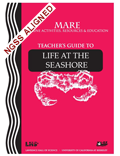Curriculum Description
Life at the Seashore
Download the NGSS/CCSS Correlations for the Life at the Seashore Curriculum
Investigation 1: Seashore Charades (5 sessions)
In this engaging activity, students discuss what they would need and what they might expect to see on a field trip to the seashore, then embark on a virtual field trip. They learn what kind of place the seashore is and observe important conditions such as waves and changing tides. Students think about and discuss what an animal or seaweed living there would need or how it might behave to help it survive. The teacher adds to their ideas as s/he provides descriptive and interesting information about some common animals and seaweeds living at the seashore. S/he then guides small groups of students as they communicate this new information to the class through charades that demonstrate different body structures and behaviors used by seashore organisms. Students discover that organisms living here have different body parts, or structures, and behaviors, that help them sense their environment, find and take in food, protect themselves from predators, and have their young. Students learn and demonstrate their understanding that these structures are related to their function.
Investigation 2: Crayfish Capers (8 sessions)
Students investigate a member of one of the most successful groups of animals in the world, the Arthropods, This group includes insects, spiders, and crustaceans such as lobsters, crabs, shrimp, beach hoppers, barnacles and crayfish. To build their understanding of how living things survive at the seashore, students observe and investigate a crustacean called a crayfish. Most crustaceans live in the ocean; however crayfish live in freshwater and thus are relatively easy to keep in the classroom. To learn more about how these organisms survive, students observe the external body parts of the crayfish and ask questions about how these organisms sense their environment. The students design and conduct an investigation to answer a question about how crayfish find and sense their food. They analyze data from another student investigation and make a claim about the structure(s) crayfish use to sense their food. Finally, students write and make labeled drawings to communicate what they have learned about crayfish.
Investigation 3: Build a Seashore (6 sessions)
At first glance, the seashore habitat, much like a human city, seems busy and too big to navigate. When we notice a pattern, like recognizing neighborhoods, we can observe how the habitat is organized and attempt to explain how living things survive and grow there. One dominant pattern, found at most seashores in the world, are the bands, or zones, in which characteristic seaweeds and animals can be found. The crashing waves and rise and fall of the tides may present challenges to survival there, but the advantages include an environment rich with food, and plentiful shelter from both land and ocean predators. The zones describe the position on the shore in relation to the tides, ranging from zones exposed to air only at the lowest of tides, to zones that are rarely underwater and only splashed by waves at high tides. Body structures and behaviors provide organisms with the means to survive in these intertidal zones, such as conserving water so they can continue to breathe and maintain a cool temperature until the high tide returns. In this activity, students research an organism and present their prediction for where on the seashore the animal would survive and grow. They build a three dimensional (3-D) seashore in their classroom, to help them better understand the distribution of the organisms living there and create a Field Trip Guide to share their understanding of the seashore with visitors coming to observe their classroom seashore.
Investigation 4: Seaweed Soup (Coming soon)
Activity 5: Tidepool Boogie (2 Sessions)
Tidepool Boogie focuses on eight different organisms representative of the diversity in this unique and rigorous habitat. Students listen to and talk about the song “Tidepool Boogie” and then work together in small groups to act out the organisms in the song. The class then stages a performance, complete with costumes.

 First Grade curriculum is focused on Life at the Seashore
First Grade curriculum is focused on Life at the Seashore


